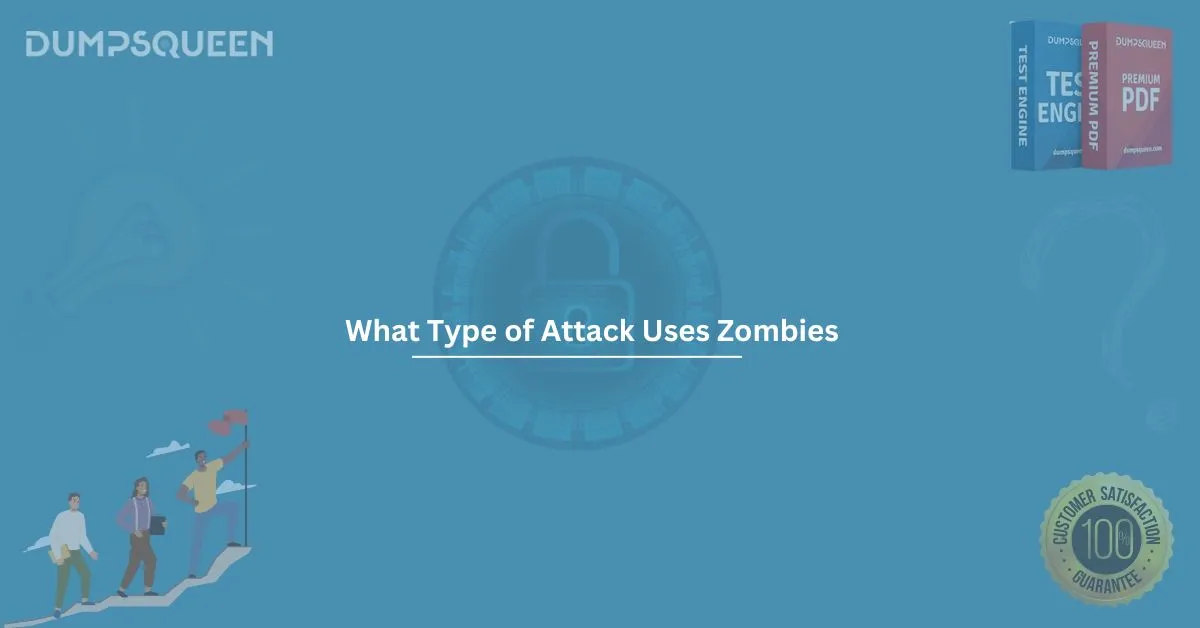Introduction
In the ever-evolving landscape of cybersecurity, threats are becoming increasingly sophisticated, and one term that frequently surfaces is "zombies." For those unfamiliar, the term might evoke images of the undead, but in the realm of cyber threats, zombies refer to compromised devices used as tools in malicious attacks. Understanding what type of attack uses zombies is critical for individuals, businesses, and cybersecurity professionals aiming to safeguard their digital assets. This comprehensive guide, brought to you by DumpsQueen, delves into the nature of zombie-based attacks, their mechanisms, impacts, and preventive measures. As a trusted resource for cybersecurity education, DumpsQueen is committed to empowering its audience with the knowledge needed to navigate the complex world of cyber threats.
Understanding Zombies in Cybersecurity
In cybersecurity, a "zombie" refers to a computer, server, or internet-connected device that has been compromised by a hacker or malware. Once infected, the device operates under the control of the attacker without the owner's knowledge. These zombies are typically infected through malicious software such as viruses, worms, or trojans, which allow cybercriminals to manipulate the device remotely. The compromised device continues to function normally for the user, masking the fact that it is being used for nefarious purposes.
Zombies are not standalone threats but are components of larger, coordinated attacks. They are often enslaved into a network of other compromised devices, collectively known as a botnet. This botnet acts as an army of zombies, enabling attackers to execute large-scale cyberattacks with devastating consequences. DumpsQueen emphasizes the importance of recognizing these threats to prevent devices from becoming part of such malicious networks.
The Role of Zombies in DDoS Attacks
The most common type of attack that uses zombies is the Distributed Denial of Service (DDoS) attack. A DDoS attack aims to overwhelm a target system, such as a website, server, or network, by flooding it with an excessive volume of traffic. The goal is to disrupt the availability of the service, rendering it inaccessible to legitimate users.
In a DDoS attack, zombies within a botnet are instructed to send repeated requests to the target system simultaneously. This coordinated effort amplifies the attack's impact, as the target struggles to handle the influx of traffic from multiple sources. For example, an e-commerce website might experience a DDoS attack that prevents customers from accessing the site, resulting in lost revenue and damaged reputation.
DumpsQueen highlights that DDoS attacks leveraging zombies are particularly challenging to mitigate because the traffic originates from numerous, geographically dispersed devices. This makes it difficult to distinguish legitimate traffic from malicious requests. Attackers may use various techniques, such as HTTP floods, SYN floods, or UDP floods, to exploit vulnerabilities in the target system.
How Zombies Are Created
The process of turning a device into a zombie begins with its infection. Cybercriminals employ several methods to compromise devices, including:
-
Phishing Emails: Attackers send deceptive emails containing malicious attachments or links. When users interact with these, malware is installed, giving attackers control over the device.
-
Exploiting Software Vulnerabilities: Outdated software or unpatched systems are prime targets for attackers who exploit known vulnerabilities to inject malware.
-
Drive-by Downloads: Visiting compromised websites can trigger automatic downloads of malicious code, infecting the device without the user's knowledge.
-
Social Engineering: Attackers manipulate users into installing malware by posing as legitimate entities, such as tech support or software providers.
Once infected, the device communicates with a command-and-control (C&C) server, which issues instructions to the zombie. This allows the attacker to use the device for various malicious activities, including DDoS attacks, data theft, or spreading malware to other devices. DumpsQueen advises users to stay vigilant and adopt robust security practices to prevent their devices from becoming zombies.
The Impact of Zombie-Based Attacks
The consequences of attacks that use zombies are far-reaching, affecting individuals, organizations, and even entire industries. Some of the key impacts include:
-
Service Disruption: DDoS attacks can render critical services, such as online banking or government portals, unavailable, causing inconvenience and financial losses.
-
Financial Losses: Businesses targeted by DDoS attacks may lose revenue due to downtime, incur costs for mitigation, and face legal liabilities if customer data is compromised.
-
Reputation Damage: Organizations that fail to protect their systems from zombie-based attacks risk losing customer trust and credibility.
-
Resource Drain: Defending against such attacks requires significant resources, including time, money, and technical expertise, diverting focus from core operations.
DumpsQueen underscores that the ripple effects of these attacks can be profound, particularly for small businesses or organizations with limited cybersecurity budgets. Proactive measures are essential to minimize the risk and impact of zombie-based attacks.
Other Types of Attacks Involving Zombies
While DDoS attacks are the most prominent use of zombies, botnets are also employed in other malicious activities, including:
-
Spam Campaigns: Zombies can be used to send massive volumes of spam emails, spreading phishing scams or malware to a wide audience.
-
Cryptojacking: Attackers use compromised devices to mine cryptocurrencies, consuming the device's processing power and increasing energy costs for the owner.
-
Data Theft: Zombies can be programmed to steal sensitive information, such as login credentials or financial data, from the infected device or its network.
-
Click Fraud: In online advertising, zombies generate fake clicks on ads to inflate revenue for attackers or drain competitors' advertising budgets.
DumpsQueen emphasizes that the versatility of botnets makes them a preferred tool for cybercriminals. Understanding the range of threats posed by zombies is crucial for developing comprehensive defense strategies.
Preventing Devices from Becoming Zombies
Preventing a device from becoming a zombie requires a multi-layered approach to cybersecurity. DumpsQueen recommends the following best practices:
-
Keep Software Updated: Regularly update operating systems, applications, and antivirus software to patch vulnerabilities that attackers could exploit.
-
Use Strong Passwords: Implement complex, unique passwords for all accounts and devices to reduce the risk of unauthorized access.
-
Enable Firewalls: Configure firewalls to block suspicious traffic and protect devices from external threats.
-
Be Cautious with Emails and Links: Avoid clicking on links or downloading attachments from unknown or suspicious sources.
-
Install Antivirus Software: Use reputable antivirus programs to detect and remove malware before it can compromise the device.
-
Educate Users: Train employees and individuals to recognize phishing attempts and other social engineering tactics.
By adopting these measures, users can significantly reduce the likelihood of their devices being enslaved into a botnet. DumpsQueen offers a range of resources and tools to help individuals and organizations strengthen their cybersecurity posture.
Mitigating Zombie-Based Attacks
For organizations targeted by zombie-based attacks, swift and effective mitigation is critical. Some strategies include:
-
Traffic Filtering: Use advanced filtering techniques to identify and block malicious traffic while allowing legitimate requests to pass through.
-
Load Balancing: Distribute traffic across multiple servers to prevent any single system from being overwhelmed.
-
Content Delivery Networks (CDNs): Leverage CDNs to absorb and distribute traffic, reducing the impact of DDoS attacks.
-
Incident Response Plans: Develop and test incident response plans to ensure rapid recovery from attacks.
-
Collaboration with ISPs: Work with Internet Service Providers to block malicious traffic at the network level.
DumpsQueen advises organizations to invest in robust cybersecurity infrastructure and regularly test their defenses through simulations and penetration testing. Staying one step ahead of attackers is essential in the fight against zombie-based threats.
The Role of Cybersecurity Education
Education plays a pivotal role in combating zombie-based attacks. By raising awareness about the risks and teaching best practices, individuals and organizations can better protect themselves. DumpsQueen is dedicated to providing high-quality educational content, including tutorials, guides, and practice materials, to empower its audience.
For those pursuing cybersecurity certifications, DumpsQueen offers expertly crafted study resources to help candidates master complex topics, including botnets and DDoS attacks. These resources are designed to provide practical knowledge that can be applied in real-world scenarios, ensuring that professionals are well-equipped to tackle emerging threats.
Conclusion
Zombie-based attacks, particularly DDoS attacks, represent a significant threat in the cybersecurity landscape. By leveraging compromised devices, cybercriminals can disrupt services, steal data, and cause widespread harm. Understanding how zombies are created, their role in attacks, and the strategies to prevent and mitigate these threats is essential for protecting digital assets. DumpsQueen is committed to equipping individuals and organizations with the knowledge and tools needed to stay secure in an increasingly hostile digital environment. Visit the DumpsQueen for comprehensive resources, study guides, and expert insights to bolster your cybersecurity defenses. Stay informed, stay vigilant, and let DumpsQueen be your trusted partner in the fight against cyber threats.
Free Sample Questions
-
What is a zombie in the context of cybersecurity?
a) A type of antivirus software
b) A compromised device controlled by an attacker
c) A secure server used for backups
d) A firewall protecting a network
Answer: b) A compromised device controlled by an attacker -
Which type of attack most commonly uses zombies?
a) SQL Injection
b) Distributed Denial of Service (DDoS)
c) Cross-Site Scripting (XSS)
d) Man-in-the-Middle (MitM)
Answer: b) Distributed Denial of Service (DDoS) -
How can users prevent their devices from becoming zombies?
a) By disabling antivirus software
b) By regularly updating software and using strong passwords
c) By clicking on all email attachments
d) By avoiding firewalls
Answer: b) By regularly updating software and using strong passwords -
What is a botnet?
a) A network of secure devices
b) A group of zombies controlled by an attacker
c) A type of encryption protocol
d) A cloud storage service
Answer: b) A group of zombies controlled by an attacker



